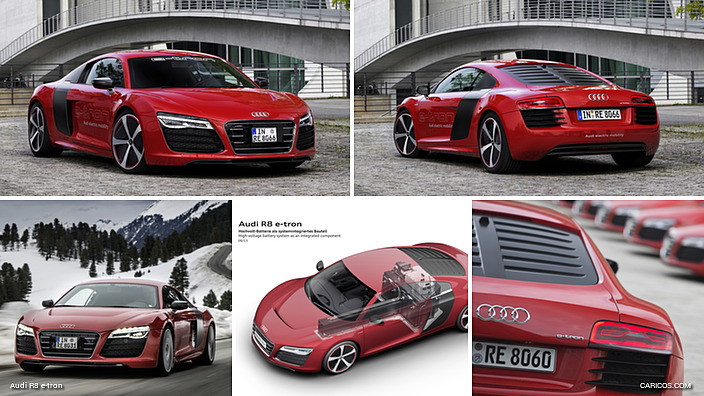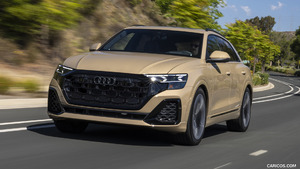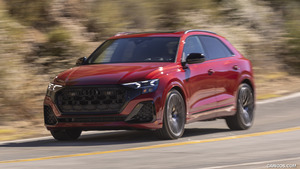Audi R8 e-tron
The Audi R8 e-tron demonstrates how emotional and dynamic electric mobility can be. Its two electric motors, supplied with energy by a large 48.6 kWh battery, develop 280 kW (380 hp) along with 820 Nm (604.80 lb-ft) of torque. They accelerate the high-performance sports car from 0 to 100 km/h (62.14 mph) in 4.2 seconds and to a governed top speed of 200 km/h (124.27 mph). The battery charge is good for an operating range of 215 kilometers (133.59 miles). Through the R8 e-tron, Audi has acquired extensive expertise that will benefit its electrified production models.
The Audi R8 e-tron weighs in at 1,780 kilograms (3,924.23 lb). Its body structure, including the side sections, weighs just 199 kilograms (438.72 lb), 23 kilograms (50.71 lb) less than that of the R8 Coupé, which already sets the bar very high with its aluminum-based ASF principle (Audi Space Frame). Here, Audi presents a new stage in the development of its ultra lightweight construction technology – a Multimaterial Space Frame, in which large parts made of carbon-fiber-reinforced polymer (CFRP) supplement the aluminum frame.
The CFRP components contribute 23 percent and the metal parts 75 percent of the bodyshell weight; miscellaneous materials make up the remainder. The forward structure of the R8 e-tron is a classic aluminum design. The dominant material in the occupant cell is CFRP, with the tail end using a blend of both materials. The supporting trunk insert of CRFP incorporates corrugated crash structures that mean the rear module can absorb five times as much energy as an aluminum lattice structure. For the B-posts and rear bulkhead, a new sandwich concept reduces the weight by 11.5 kilograms (25.35 lb).
 2013 Audi R8 e-tron
2013 Audi R8 e-tron
Every single part of the outer skin, which is made almost entirely of CFRP, is tailored specifically to its position and purpose. In certain zones of the front lid, for instance, there are seven layers of carbon fiber matting one on top of the other. For the inner shells of the rear side sections, on the other hand, two layers incorporating nonwoven material are adequate.
The lithium-ion battery, too, is a reflection of the development expertise of Audi – it was designed and built in-house. Bolted to the structure at 40 points, it functions as a supporting element that more than doubles the rigidity of the Multimaterial Space Frame. The battery incorporates 530 prismatic flat cells. Taking the shape of a T, the battery is 235 centimeters (92.52 in) long, 135 centimeters (53.15 in) wide and, control unit included, 71 centimeters (27.95 in) high. Around the tunnel there are two floors with cell modules one above the other; at the rear end there are four floors.
Plates 12 millimeters (0.47 in) thick made from high-strength aluminum alloys separate the floors, while forming the battery’s supporting structure. The coolant circulates through narrow channels cut into these, with a total length of several hundred meters. A hydraulic distributor maintains a precisely calculated, smooth flow serving all cells equally.
The battery management system is housed together with the high-voltage switches and power fuses in the electrics box, which is located on the traction battery. The main tasks of the battery management system involve monitoring the battery system’s safety and, if need be, taking appropriate measures to prevent danger. It also determines the charge status and performance of the HV battery and transmits the readings to the electric motors’ drive controllers. To do that, the battery management system, for example, accesses a battery-internal network of cell electronics, to gage cell voltages and temperatures. If the battery’s charge level falls towards the threshold of 15 percent SOC (state of charge), the controller correspondingly reduces the amount of electrical power that can be taken from the battery. In addition, the functioning and safety of the high-voltage electrical system are permanently monitored; in the event of an accident, the battery is deactivated.
There are two options available for charging the battery: A full charge with 230-volt alternating current from the domestic mains takes about twelve hours. Charging with direct current cuts the time required to less than one hour, depending on the connected load. The driver can control and monitor a wide range of functions and information remotely by smartphone app, including the charge status, the interior heating and the range display. This is a customized service from Audi connect, which is also used in a very similar form in models such as the A3 Sportback e-tron.
The battery is also recharged while on the road by means of energy recovery during retardation phases. The driver chooses the degree of energy recovery in three stages (plus freewheeling) at paddles on the steering wheel. The rate is especially high when braking because up to about 0.3 g the electric motors normally handle retardation on their own. Beyond that the front brake system then gradually comes into play, and the electric motors can recover up to 0.45 g. The newly developed electric individual-wheel traction control (eASR) maintains excellent stability when braking, and provides compelling traction when accelerating.
The two electric motors on the rear axle of the Audi R8 e-tron enable electric torque vectoring, the targeted braking and acceleration of individual wheels for on-demand torque distribution during fast cornering. Thanks to the separate activation of the electric motors and their spontaneous behavior, this function is highly variable and fast; in theory the high-performance sports car can brake one wheel while powering the other with high torque.
With a total of 280 kW and 820 Nm (604.80 lb-ft) available virtually from off, the electric motors give the Audi R8 e-tron impressive performance. They catapult it from 0 to 100 km/h (62.14 mph) in 4.2 seconds, and top speed is limited to 200 km/h (124.27 mph). In the test-bench cycle, one battery charge is sufficient for driving over 215 kilometers (133.59 miles).
The electric motors achieve over 95 percent efficiency over a wide range; ungoverned, they could rev up to 12,500 rpm, which would make them capable of a speed of more than 250 km/h (155.34 mph). Designed as permanently excited synchronous machines, they deliver a high performance and torque density and can also run efficiently on a small amount of electricity. The stator temperature is controlled by a water jacket, and the air additionally cooled by an air flow. The single-stage planetary gears are incorporated into the cooling circuit.
Each electric motor is supplied by separate power electronics, which are likewise temperature-controlled. The pulse inverters that convert the battery’s direct-current voltage into alternating-current voltage redefine the benchmark for compact, lightweight design. The driveline’s control concept has designed-in redundancy and satisfies the highest possible safety standards – the controllers of the power electronics communicate with each other and with the drive controllers.
The chassis of the Audi R8 e-tron, too, features new solutions. The coil springs are made from glass-fiber-reinforced polymer (GFRP) and weigh only 1.2 and 1.3 kilograms (2.65 and 2.87 lb) respectively, about 40 percent less than steel springs. The rear wheel hubs are of forged titanium, saving 0.6 kilograms (1.32 lb) of weight. For the anti-roll bar at the front, wound layers of CFRP form the tube, and the shanks are made from aluminum – the component weighs just 2.5 kilograms (5.51 lb), a saving of 35 percent.
The Audi R8 e-tron is fitted with size 225/35 and 275/35 tires with optimized rolling resistance. From about 50 km/h (31.07 mph), adjustable flaps close the apertures in the 19-inch wheels by centrifugal force; at low speeds they open again. The active aerodynamic wheels trim about 0.02 off the cD value.
The wheel brakes at the rear are electromechanical screw brakes. Electrically actuated and controlled ball screw drives (“by wire”) press the pads against the disks with lightning speed. There is a hydraulic brake system on the front wheels, with two vacuum pumps generating the required partial vacuum. Here, the disks are made from carbon fiber ceramic.
With a weight distribution of 42:58, the R8 e-tron is equipped with just the right basis for sporty handling. The battery is located between the axles, with a low installed position that lowers the vehicle center of gravity. Racing driver Markus Winkelhock established two new records for electric-drive production vehicles with the R8 e-tron on the Nürburgring North Loop. He clocked up 8:09.099 minutes for the fastest single lap and 16:56.966 minutes for two successive laps. For the single lap he drove on sports tires approved for a top speed of 250 km/h (155.34 mph), and used standard tires with a 200 km/h (124.27 mph) speed limit for the double lap. The Audi R8 e-tron looks similar to the Audi R8 with gasoline engine, but the two vehicle body versions share only nine common parts. The drag coefficient of the electrically powered high-performance sports car is cD = 0.27. The absence of a combustion engine, transmission and exhaust system permit a smooth underbody. At its rear end a long, relatively steeply raked diffuser deflects the air in a way that harmonizes with the air flow around the tail end. The spoiler edge is slightly higher than on the R8, and there is no spoiler.
The electrically powered high-performance sports car does not have an oil cooler, nor does it need intake air. Its side air inlets at the front as well as the sideblades are sealed. Cooling air is only admitted through the lower part of the Singleframe grille. It is required for the thermal management. It flows through the forward structure in a duct and emerges again through an opening in the front lid.
In the shape of the multi-source heat pump, Audi has realized a high-performance thermal management solution for the R8 e-tron that will be of great benefit to future production models. The highly complex system keeps all important driveline components – the battery, the electric motors, the transmissions and the power electronics – at the ideal temperature level. The heat that it draws off is used to regulate the interior climate. The efficient use of electrical energy boosts the range by up to 20 percent.
The heat pump is based on the principle of the classic refrigerant circuit. As a new component, it incorporates chillers (elements which handle heat exchange between two fluids), the front condenser/evaporator, electrically operated expansion valves and an additional heater controller in the air conditioning unit. A heat coordinator developed by Audi manages how the subsystems interact; depending on the situation, it chooses the best from 43 variants. The heat pump in the R8 e-tron, which also operates independently, heats up the interior faster than a conventional heating or air conditioning system. With an electrical output of 1 kW, it can supply up to 3 kW of heating performance.
When the system operates as an air-source heat pump, it draws heat from the ambient air. Heat is transferred to the refrigerant circuit via the front condenser, which in this instance operates as an evaporator. At low outside temperatures the heat pump makes use of the waste heat from the electric motors and high-voltage battery via special evaporators, the chillers, which simultaneously cool the assemblies. The heater controller usually heats up the interior by transferring the thermal energy stored in the refrigerant to the fresh air drawn in. An electric PTC auxiliary heater only cuts in if maximum heating speed is required.
The interior of the Audi R8 e-tron features elegant CFRP surfaces, soft leather and Alcantara. The sport bucket seats have a CFRP chassis; each of them weighs only 17.6 kilograms (38.80 lb). In the instrument cluster, LED strips indicate the coolant temperature and battery charge level. The large powermeter presents the level of power output and energy recovery on a scale from 0 to 100 percent. There is a 7-inch color monitor for the driver information system; together with the MMI monitor it shows all important facts about electric driving. These include power consumption (in kW/h per 100 km), the chosen energy recovery level, the amount of energy recovered and an animated graphic of the energy flow. In addition, the range is displayed graphically in the navigation system’s map view.
The digital interior mirror is another innovation in the Audi R8 e-tron. A high-resolution display measuring 6.8 inches diagonally, in AMOLED technology (active matrix organic light emitting diode), takes the place of the interior mirror. A small, very high-performance camera captures the image across a wide field of view and with high sensitivity. A control unit ensures that the image appearing on the display always has high contrast and brilliance. The AMOLED display, a mere 7 millimeters (0.28 in) thick, offers ten times the contrast and 30 percent better energy efficiency compared with an LCD monitor.
Audi has equipped the R8 e-tron with a synthetic e-sound, which is audible up to about 60 km/h (37.28 mph). A small computer generates the frequencies from data supplied by the drive controller, and a sturdy speaker system on the underbody directs it to the road surface.
- Output: 2 x 140 kW
- Maximum torque: 2 x 410 Nm (2 x 302.40 lb-ft)
- Battery capacity: 48.6 kWh
- 0 – 100 km/h (62.14 mph): 4.2 s
- Operating range in NEDC cycle: 215 km (133.59 mph)
- Top speed: 200 km/h (124.27 mph)*
- Length / width / height: 4,431 / 2,029** / 1,252 mm (14.54 / 6.66 / 4.11 ft)
- Wheelbase: 2,650 mm (8.69 ft)
- Unladen weight: 1,780 kg (3,924.23 lb)













